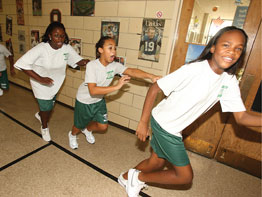Whÿsper Irving wasn’t about to let one of her classmates hit her with the dodge ball during a recent physical education class at John Paul Regional School in Woodlawn.
Racing through the gymnasium, the 12-year-old seventh-grader successfully eluded her fleet-footed pursuer – quickly changing course as she followed the lines painted on the gym floor.
“It’s fun!” said Whÿsper, not in the least bit winded after completing the exercise. “I think these kinds of games build strength and stamina. They’re educational, too.”
Making physical activity enjoyable is at the heart of the physical education program at John Paul Regional. The goal is to help students cultivate an appreciation for sports at a young age and then carry that love into adulthood, according to Vicki Kelley, John Paul Regional’s physical education instructor for the last 17 years.
“We’re introducing them to new sports that they’ll be able to play on their own,” she said. Some of the new activities have included badminton and bocce ball.
Consistent with national trends of recent years, Ms. Kelley has noticed an increase in the number of obese children at John Paul Regional.
“We used to go outside and play all day,” she said. “Kids today often stay home. It’s vital to get them active.”
Theresa Brooks, principal, said physical education is receiving renewed emphasis at her school. All students are required to take physical education classes once a week during 45-minute sessions. They also participate in a Field Day program and Jump Rope for the Heart.
Five years ago, the school got rid of junk food and introduced healthy alternatives like yogurt, fresh fruit and salads. No soda is allowed on campus, and the school sells only water, milk, orange juice and apple juice.
“We encourage them to drink water throughout the day,” said Ms. Brooks, noting that children are permitted to carry water bottles with them year-round.
Leslie Andrathy, archdiocesan assistant superintendent for curriculum and professional development, said the archdiocese has a curriculum for physical education based on the National Standards for Physical Education. While schools are not mandated to have physical education classes, Ms. Andrathy noted that all schools in the archdiocese offer some form of physical education. Because of limited resources, some share physical education instructors, she said.
“We give our teachers real freedom to find resources that will supplement their programs,” said Ms. Andrathy, noting that some schools offer indoor bowling, indoor tennis, dance and other innovative activities.
At the upcoming Archdiocese of Baltimore Conference for Catholic Educators, Oct. 6-7, two sessions will focus on fitness and nutrition, she said.


